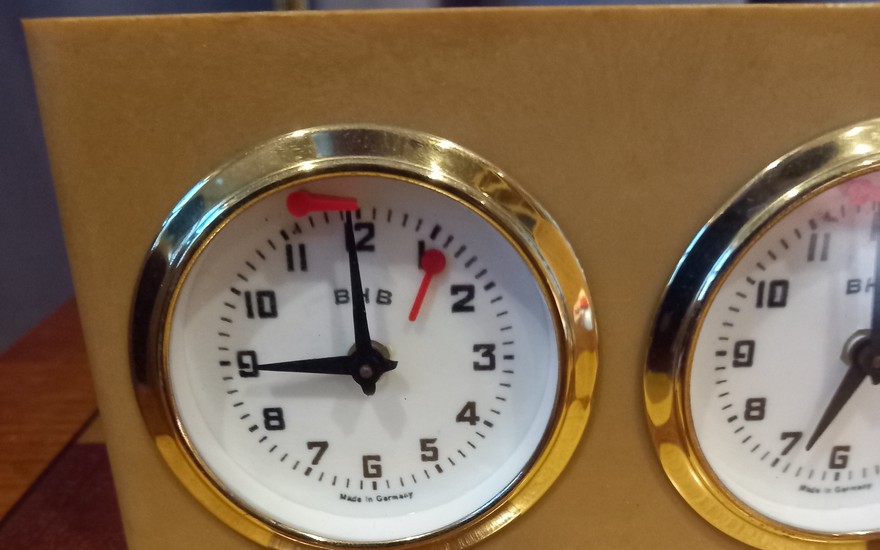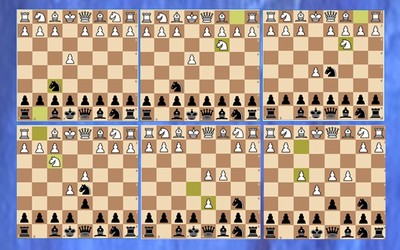
Tick tock, tick tock, tick...
Should you get into time trouble more often?
Most of us are advised as beginners not to get into time trouble. Some of us even manage to avoid it. However, some very successful players routinely fall short on time. Are the rest of us missing a trick?Why falling short on time could be a problem?
Of course the time limit you are playing is critical.
For blitz I reviewed some online tournaments and would estimate that around 20% of games end by loss on time for a classic 5-minute game. That rises to around 25% for 3-minute games. With increment it falls to around 15% for 3-minute with 2 seconds increment. For bullet time loss occurred in over 50% of games. So in blitz and bullet there is a clear cost to falling behind on the clock. You could still risk it if you were very very fast at recovering, but for most of us getting into time trouble at blitz is a bad idea.
For classical and rapid games the question is more interesting. That's what we'll focus on in this blog. In classical games I would guess a very small number of games end with loss on time, maybe 1% or less where there is increment. That percentage will be higher where there is no increment as often happens in club games. And the risk is that although we will usually avoid a direct loss on time we will play much weaker moves as our time falls very short.
What are the benefits of falling short on time?
But it's not all bad! If you fall short on time, then at least you have used all of your time. You may even have used it wisely to find some good moves.
And when you do fall short on time, it's not always easy for your opponent to take advantage. Their natural rhythm of play will be impacted. They'll no longer have a couple of minutes or more between their moves to reflect on the position. They may rush themselves and make errors. At the same time if you're used to this situation then you can play in a more composed way.
How do experienced players use their time at classical chess?
The graph below shows how a selection of players used their time in a classical tournament, the 2022 English 50+ Championships. This includes me and my opponents in the 7-round contest. The two titled players GM Mark Hebden and IM Andrew Ledger are in the middle. The rest of the players would fall under the category of strong club players, mostly around 2000-2100 Elo. The time limit was all moves in 90 minutes with 30 seconds increment after each move.

Each bar on the graph represents the average minutes per move for a particular band of moves. For example, the first dark bar shows that most of the players used around one minute per move for their first 10 moves. Andrey Churavin was the quickest using only 15 seconds or so. Carl Portman and Ian Thompson invested a couple of minutes per move.
You can see that for most players the highest bar is for moves 11-20 and the next highest for moves 21-30. That's consistent with most of the players spending the most time on the early and late middlegame. Only Churavin had a different overall pattern - he was just quick for all of his moves, aiming to pressure his opponents throughout the game.
The 4th and 5th bars for each player show a general trend of players speeding up as their 90 minute allowance runs down.
Another way to look at this sort of data is to look at the time remaining rather than the time used. That's what the next graph does, also based on data from the same English championships.

In the graph above I've just kept three players from the first graph (the fast Churavin, and the more normal paced GM Hebden and me). I've added in GM Peter Wells, famous as a player, author, national captain and coach. But he's also well known as someone who regularly falls short on time.
On this graph the time remaining for each player is grouped together in each move-band. If we focus in on Peter Wells we can see that his yellow bar falls much more quickly than the others. Already at the 21-30 move band he is falling to around 10 minutes. Beyond move 30 his bar is barely visible as he is essentially playing on increment.
In the data above the two extreme time strategies are represented by the very quick Churavin and the much slower Wells. Incidentally, Hebden with a more medium pace won both tournaments he entered (Open and 50+). However, a couple of tournament victories isn't really enough to judge the merits of the players' time strategies. Therefore, in the next section we delve a little deeper into the impacts of time usage on move quality.
How can we use data to understand the impacts of using a lot of time early in the game?
Data on the time taken per move isn't recorded as regularly or systematically as move data. Therefore in the tables below I have taken players that are already known to be slow, quick or medium-paced.
To help us ground ourselves in the approach the first table has players generally considered medium-paced. Not ordinary players though! We have three world champions, two grandmasters and finally me.
For each player in the tables below I took around 100 games, mostly in the couple of years before the pandemic. For "Older Anand" (more on this label to follow) I took games a few years earlier when he was still playing world championship matches.
The next table starts with an overall error rate against Stockfish as calculated by ChessBase 17. For world champions this is around 0.1 "pawns" per move. More regular grandmasters such as Hebden and Arkell clock in around 0.2 pawns per move. As a 2100 club player I averaged 0.34 pawns.
The next columns break down the 100 games into 10 move chunks. I did the chunking manually within ChessBase, but someone with better coding skills could automate this process to get a higher volume of games.

I don't show error rates for the first 10 moves as these will mostly be known openings. For moves 11-20 the error rates are slightly less than the overall game average. For this part of the game openings and decent plans are often known. The error rates increase as we move into moves 21-30 and 31-40. Here positions will usually be less familiar and time may also run lower.
The key part of the analysis is in the penultimate column. This takes the ratio of errors for moves 31-40 to the errors for moves 11-20. The hypothesis is that time trouble addicts could have a higher ratio as they will have little time left for the final 10 moves. For the medium-paced players in our table that ratio is around 2, so the error rate is doubled for those final 10 moves versus moves 11-20.
The hare and the tortoise
The next table shows players known to be fast. The final table will show players known to be slow.
For the fast players I chose IM Jack Rudd, well known and feared in the UK for playing a very fast style. I expect this player's time profile would be similar to Churavin's above, but helpfully there are more database games. Nepo is known as a player who pressures his opponents on the clock. Anand started his career playing very quickly - his games here go back to the early 1990s. For all of these players the late to early ratio is less than two. That means they are avoiding increasing their error rate as the typical time control around move 40 is reached.
However, there may be a cost in terms of a higher overall error rate. For, example Anand has almost twice the error rate in this period versus when he was older and world champion. In part that will be because his game had not fully matured. Nepo is much closer to the error rate of the likes of Carsen and Ding, and his fast play will likely be increasing the error rate of his opponents. For him the fast strategy seems to be working.
For IM Jack Rudd an error rate of 0.37 is a touch higher even than my own of 0.34 (and I'm 250+ Elo points off being IM standard). Here I'm less convinced this is the best speed of play to maximise win rate.

In the final table we see that the known time trouble addicts all have a late to early ratio of over two. That means there is some above average deterioration in their move quality just before move 40. However, they all have very low error rates for moves 11-20. It's difficult to form a conclusion as to whether they are playing their best time strategies. Grischuk has competed for many years at an elite level, but would his results have been even better if he had sped up?
There's one interesting observation we can make on the final column of this table. Peter Wells is only continuing 25% of his games beyond move 40. That means that he is getting good value from his time. On the other hand, David Howell regularly commentates on how much he loves long games. He even wrote a book with Magnus Carlsen around the subject. Over 57% of his games go beyond move 40. Given he expects to still be playing beyond move 40, there's a greater argument for keeping some time in reserve.
So what should we do?
As with many big questions, it's difficult to come to a firm conclusion. Some players manage very well by getting into regular time trouble. Interestingly some of these players like Grischuk are exceptional blitz players. Being good at blitz means you should be able to cope better when you get short of time. However, there is always a risk of just not being able to work out a good move when you're down to seconds. That makes it a high risk strategy.
One possibility is to change your own time approach according to your view of your opponent's skills at different speeds. In essence if you think you're much better at blitz than your opponent then you might want to try and get them into time trouble, even if that means you are also short of time. You might do that by leaving recognised openings early, or by playing in a particularly sharp manner.
The graph below illustrates this. Playing strength in Elo is shown on the vertical axis and speed of play increases from left to right. The top dotted line represents a computer engine which will be very strong at all speeds of play and deteriorate only slightly with less time.
The solid line represents a player who is better than the player with the lowest dashed line at all speeds. However, the gap is biggest at blitz speeds so there is an argument for the solid line player to seek to get their dashed line opponent short on time.

Of course you won't know the exact shape of your opponent's line. However, you might have rapid as well as classical ratings or you might consider age an indication.
Finally, the structure of the time controls should impact your decisions. If you get a second or even third chunk of time later in the game or if you get increment per move, then getting short on time is much less risky.
If you liked the discussion, please "like it". Please also feel free to comment in the forum.
If you are interested in this and similar topics, then you might enjoy my book available on Amazon Better Chess Faster: Strategies for online and live play: Amazon.co.uk: Crocker, Mr Phil: 9798829874704: Books

More blog posts by Schadenfreude__gut

Doubled pawns: in 14 flavours
Whether they are good or bad there is something a bit sinister about how doubled pawns are normally …
Understand Alekhine's Defence in six diagrams
The Alekhine is a combative opening which can do particularly well at blitz and can pose immediate p…
Improve your blitz results in eight steps
Have you ever wondered if there are some easy ways to make you faster and more dangerous at blitz? H…
